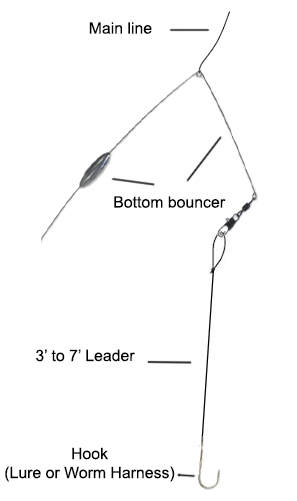A bottom bouncer rig is a good presentation for trolling for walleye, but it can also be fished from shore. The bottom bounder rig is an L-shaped wire with an oval weight affixed at the middle of the long end. On the short end of the L wire, there is a snap swivel. The main fishing line attaches to the rig at the corner notch where the two wire ends connect. Lastly, a leader line, with hook, is attached to the snap swivel.

Your leader line can be anywhere from 3′ to 7′, but a shorter 36-42″ leader will help keep your rig up off the bottom. Various leader lines will work, but fluorocarbon tends to perform best when fishing walleye.
The design of the bottom bouncer rig is great for trolling, especially if you need to keep your bait near the bottom as you move along. The weighted end of L-shaped wire on the bottom bouncer rig will point downwards from the rig, which helps it to avoid snags as the rig moves along the bottom through the water.
Bottom Bounder Rig Weights
One of the keys to fishing a bottom bounder rig is to make sure you the correct weight for your target depth. You want to fish your bottom bouncer in contact, or in close contact, with the bottom—but you don’t want your bottom bouncer dragging along the bottom. Ideally, your bottom bouncer should tick lightly off the bottom as it moves through the water.
The following chart indicates the suggested weights to use for fishing a bottom bouncer at different depths. These weights are specifically recommended for fishing for walleye.
- 10′-15′ of water = 1oz weight
- 15′-20″ of water = 1.5oz weight
- 20′-30′ of water = 2oz weight
- 25′-35′ of water = 3oz weight
- 30′-40′ of water = 4oz weight
As a rule of thumb, add 1 ounce of weight for every ten feet of water. You may also need to adjust weight up when trolling at faster speeds.
Walleye Bottom Bouncer Trolling Tips and Setup
Rod setup is key when using a bottom bouncer to troll for walleye. Ideally you want to use a 7′-8′ medium action rod with a parabolic bend. A parabolic rod has a real soft bend that allows a walleye to take the bait without feeling any initial resistance from the rod. The hook is softly, yet firmly, set from the forward motion of the boat rather than a sudden hookset. Once the fish is hooked, pick up the rod and reel in your catch.
You can use spinning gear or a baitcaster when trolling for walleye with a bottom bouncer rig. I prefer using my baitcaster with a flip and switch reel when trolling for walleye. The following are the steps for setting up a walleye troll using a baitcaster with a bottom bouncer.
- Drop your bottom bounder rig in the water.
- Free spool your reel until the rig hits the bottom.
- When the rig hits the bottom stop the spool with your thumb.
- Now—with the boat moving forward—maintain your thumb on the spool until the line pulls tight.
- Remove your thumb from the spool and let out the line again until the rig hit the bottom a second time.
- Now click the reel over and place your rod in the rod holder. (You’re line should now be going down at about a 45 degree angle.)
For walleye fishing there are several bottom bouncers you can use. My favorite is the Spin n Glo Bottom Walker which provides a little bit more action than a traditional bottom bouncer.
A Fin-Tech bottom bouncer with a quick change system that allows you to easily slide different size weights on and off is another great option. The quick change system is ideal when you know you’ll be changing depths and will need to swap out weights.
As far the terminal tackle goes, for trolling walleyes you can miss with a Mack’s Smill Blade, followed by a couple of beads, and slow death hook tipped with half a nightcrawler.
Bottom Bouncer Trolling Speed
You’ll also need to find the right trolling speed—a speed that maintains your bottom bouncer rig in continual contact with the bottom while avoiding snags. A recommended trolling speed for walleye fishing using a bottom bouncer is between 1 and 1.5 MPH. Troll speed may need to be adjusted to account for current.



